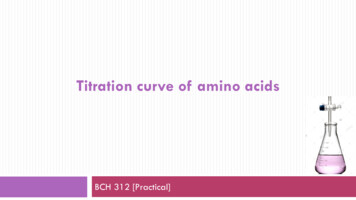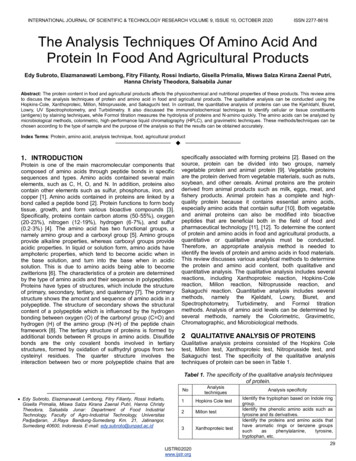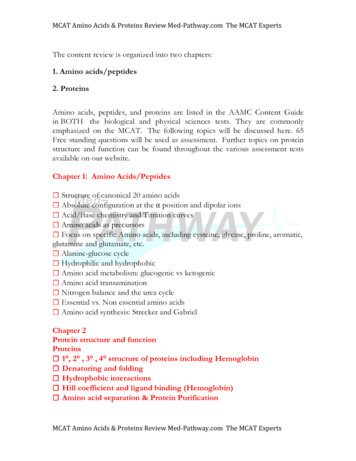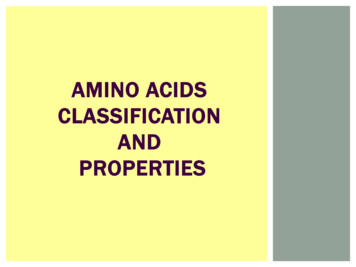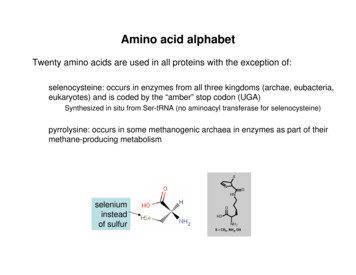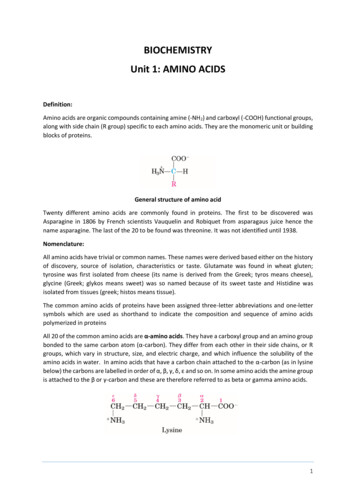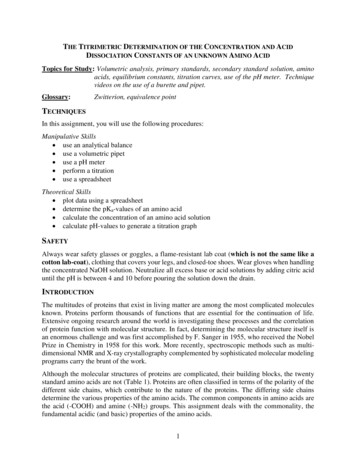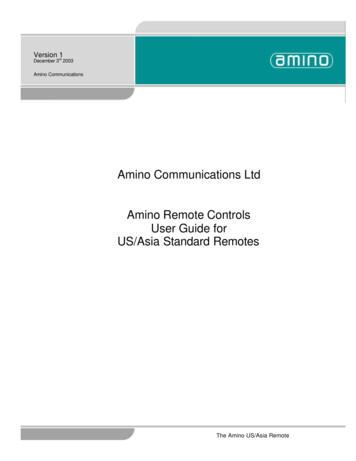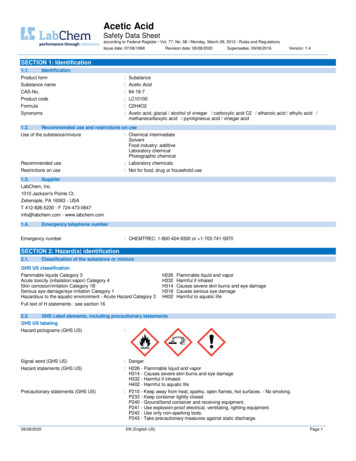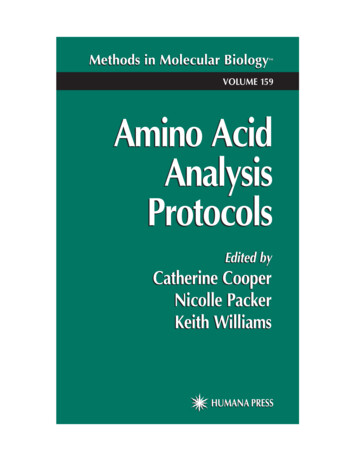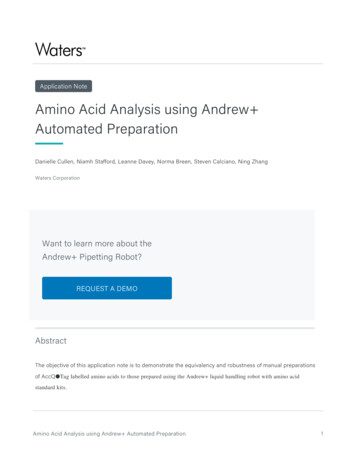
Transcription
Application NoteAmino Acid Analysis using Andrew Automated PreparationDanielle Cullen, Niamh Stafford, Leanne Davey, Norma Breen, Steven Calciano, Ning ZhangWaters CorporationWant to learn more about theAndrew Pipetting Robot?REQUEST A DEMOAbstractThe objective of this application note is to demonstrate the equivalency and robustness of manual preparationsof AccQ Tag labelled amino acids to those prepared using the Andrew liquid handling robot with amino acidstandard kits.Amino Acid Analysis using Andrew Automated Preparation1
IntroductionAmino acids are the most basic components that make up proteins, thus making them essential components ofcell culture media and food stuffs. Monitoring and optimizing the amino acid components of bioreactor media isessential for ensuring the best growing conditions for the cells. Likewise, it is necessary to confirm that foodproducts meet specified requirements. Therefore, the analysis of amino acids is a critical routine process.The preparation and analysis of samples is a time-consuming process that can dominate an analyst’s time in thelaboratory. Automated laboratory preparation systems provide the flexibility of freeing analysts time for othertasks, resulting in a more efficient way of time management. Waters has created automated sample preparationprotocols for the Andrew Alliance Andrew platform in conjunction with the AccQ Tag Ultra DerivatizationAutomation Kit (p/n: 186009232) (Figure 1) and amino acid standard kits. The AccQ Tag Ultra Derivatization Kitfor automation scales up reagent volumes necessary for use with automation systems due to their increased dead volumerequirements. The reagent volumes provided allow for the preparation of up to 96 samples in a 3 x 32 sample format.Figure 1. AccQ Tag Ultra Derivatization Automation Kit.A food and feed kit containing 21 amino acids and an amino acid cell culture standard kit containing 26 aminoacids (Table 1) is available. Protocols for the Andrew liquid handling robot are stored in OneLab, a cloud-basedsoftware with an intuitive user-friendly graphical interface. Cell culture and food and feed amino acid standardsWant to learn more about the Andrew Pipetting Robot?2
are used in this application note to demonstrate the results obtained from both manual and automated samplepreparations.Want to learn more about the Andrew Pipetting Robot?3
Table 1. Amino acid composition of Cell Culture Standard Kit.Want to learn more about the Andrew Pipetting Robot?4
ExperimentalThe workflow consisted of manual or automated sample preparation followed by LC analysis and dataprocessing in Empower Software.Figure 2. Systems and software used in the AccQ Tag workflow.Want to learn more about the Andrew Pipetting Robot?5
Analytical Method ConditionsTable 2. AccQ Tag profiling method for cell culture/food and feed.Design FactorsProtocol featuresA set of three sample preparation protocols (32, 64, and 96 samples) were created for the Andrew liquidhandling robot based on the AccQ Tag derivatization automation kit. In addition, calibration line and reagentpreparation protocols are available in OneLab, a protocol design and execution software for connected devices. Thecalibration line protocol provides the ability to perform dilution of standards with a reference range of 500 µM to 0.5µM (cystine 250 µM to 0.25 µM). The resulting diluted standards can then be used with the sample preparationprotocols as a 7-point calibration line.The reagent preparation protocol can be used in conjunction with Pipette connected electronic pipettes toprepare reagents and standards for the sample preparation and derivatization protocol. There is also theflexibility to include the Norvaline Internal Standard (p/n: 186009301) when preparing samples.Want to learn more about the Andrew Pipetting Robot?6
LabwareThe manual preparation of amino acid samples with the AccQ Tag Derivatization Kit was performed using WatersTotal Recovery Vials. In order to make this automation compatible, the total recovery glass vials were replaced with a96-well Lo Bind PCR plate (p/n: 0030129555). This labware was also appropriate for use with the Shaker ,Peltier and gripper devices during preparation. Testing was conducted to support the labware change and noimpact to product performance was detected.Experimental DesignManual and Andrew sample preparations were performed for the food and feed and cell culture standardpreparations. The AccQ Tag Ultra Derivatization automation kits were used along with a minimum of two differentcolumn lots and AccQ Tag Ultra mobile phase eluents. Three solvent panels (0.1 M HCl) were created at levelsspanning the concentration range (10 µM, 200 µM, and 400 µM) for both food and feed and cell culture. These panelscontained the relevant amino acids to assess preparation performance.Results and DiscussionThe automated preparation method using the Andrew platform was assessed and compared to the manualpreparation method for robustness and equivalency. Performance characteristics were monitored across threeconcentration levels (10 µM, 200 µM, and 400 µM) to determine the accuracy and precision (retention time,analyte peak area, and concentration) as well as the linearity of these results. A total of 18 samples wereassessed using the AccQ Tag Ultra 32-sample protocol with six preparations at each level. Panels were prepared insinglicate and injected in duplicate. The first injection was used in the calculation of the results. The duplicateinjection is only analyzed as a backup in case of instrument issues. Norvaline internal standard was used in allexperiments. The use of a Norvaline internal standard best compensates for the variability generated in samplehydrolysis and amino acid analysis.Want to learn more about the Andrew Pipetting Robot?7
Figure 3. Separation of 10 pmols of the cell culture standard spiked with 23.5 pmols of Nva on column.Figure 4. Separation of 10 pmols of the food and feed standard spiked with 23.5 pmols of Nva on column.PrecisionTo demonstrate the repeatability of the automated sample preparation in comparison to the manual preparation,the %CV for each concentration level was determined. The maximum mean %CV across all amino acids and allconcentration levels for cell culture Andrew and manual preparation was 2.0% and 2.3%, respectively. Themaximum mean %CV across all amino acids and all concentration levels for food and feed Andrew was 1.7%and for manual it was 2.8%. The data in Tables 3 and 4 indicate comparable precision between Andrew andWant to learn more about the Andrew Pipetting Robot?8
manual preparation.Table 3. Cell culture %CV Andrew and manual preparation across 10 µM, 200 µM, and 400 µM solvent panels.*A second injection was used due to integration error.Want to learn more about the Andrew Pipetting Robot?9
Table 4. Food and feed %CV for Andrew and manual preparation across 10 µM, 200 µM, and 400 μM solventpanels.AccuracyAccuracy was assessed at concentrations of 10 µM, 200 µM, and 400 µM using six preparations at eachconcentration level. The average concentration of the six preparations is used to calculate the difference from thetarget value in order to find the %Recovery. The %Recovery for each amino acid for both cell culture and foodand feed was within 10% of the target concentration (Tables 5 and 6). This recovery data demonstrates thesuitability of Andrew as a great time-saving alternative to manually derivatizing amino acids.Want to learn more about the Andrew Pipetting Robot?10
Table 5. Cell culture amino acid standard %Recovery from target values.Want to learn more about the Andrew Pipetting Robot?11
Table 6. Food and feed amino acid standard %Recovery from target values.LinearityLinearity was assessed using a cell culture standard prepared at seven concentration levels for each amino acidacross a range of 0.5 µM–500 µM (Cystine 0.25 µM–250 µM). All analytical runs were assessed for linearity andall met the criteria of r2 0.995 with no point deviation from the expected concentration by 15% for calibrators2–7 (2.5 µM–500 µM) and 20% for calibrator 1 (0.5 µM). The data was consistent between manual andautomated preparation methods and no trends were observed.Want to learn more about the Andrew Pipetting Robot?12
Table 7. R2 values for line generated using the Waters Amino Acid Cell Culture Standard. All lines passedWant to learn more about the Andrew Pipetting Robot?13
acceptance criteria of having an R2 value greater than 0.995.Want to learn more about the Andrew Pipetting Robot?14
Table 8. R2 values for line generated using the Waters Amino Acid Food and Feed Standard. All lines passedWant to learn more about the Andrew Pipetting Robot?15
acceptance criteria of having an R2 value greater than 0.995.ConclusionThe performance characteristics of precision, accuracy, and linearity were used to determine the equivalence ofthe Andrew preparations to manual preparations. The results indicate excellent comparability between the twosample preparation methods for the UPLC Amino Acid Analysis Solution, however there are convenient benefitsto automation that must also be considered when performing a comparative analysis: The Andrew robot provides efficiency without compromising accuracy and precision with calibration linepreparation and sample preparation performed in under an hour. The automation protocol developed requires no manual intervention during the run, taking advantage offeatures like the Bluetooth configured pipettes which switch between volumes and the gripper device totransfer labware, thus allowing the analyst time to perform other laboratory tasks. The OneLab cloud-based software allows the user to monitor the run from any internet connected computeror tablet they have available. The use of automation removes analyst-to-analyst variation allowing laboratories and companies tostandardize analysis methods and facilitate method transfer between multiple sites.AcknowledgementsDanielle Cullen, Niamh Stafford, Leanne Davey, Norma Breen (Waters Technologies Ireland Ltd); StevenCalciano, Ning Zhang (Waters Corporation, Milford, MA).Featured ProductsACQUITY UPLC H-Class PLUS Bio System https://www.waters.com/10166246 Want to learn more about the Andrew Pipetting Robot?16
ACQUITY UPLC Tunable UV Detector https://www.waters.com/514228 Automated Liquid Handling for LC & LC-MS Sample Preparation Workflows https://www.waters.com/waters/nav.htm?cid 135070059 Empower Chromatography Data System https://www.waters.com/10190669 720007042, September 2020 2022 Waters Corporation. All Rights Reserved.Terms of UsePrivacyCookie PreferencesTrademarksWant to learn more about the Andrew Pipetting Robot?SitemapCareersCookies17
A food and feed kit containing 21 amino acids and an amino acid cell culture standard kit containing 26 amino acids (Table 1) is available. Protocols for the Andrew liquid handling robot are stored in OneLab, a cloud-based software with an intuitive user-friendly graphical interface. Cell culture and food and feed amino acid standards
